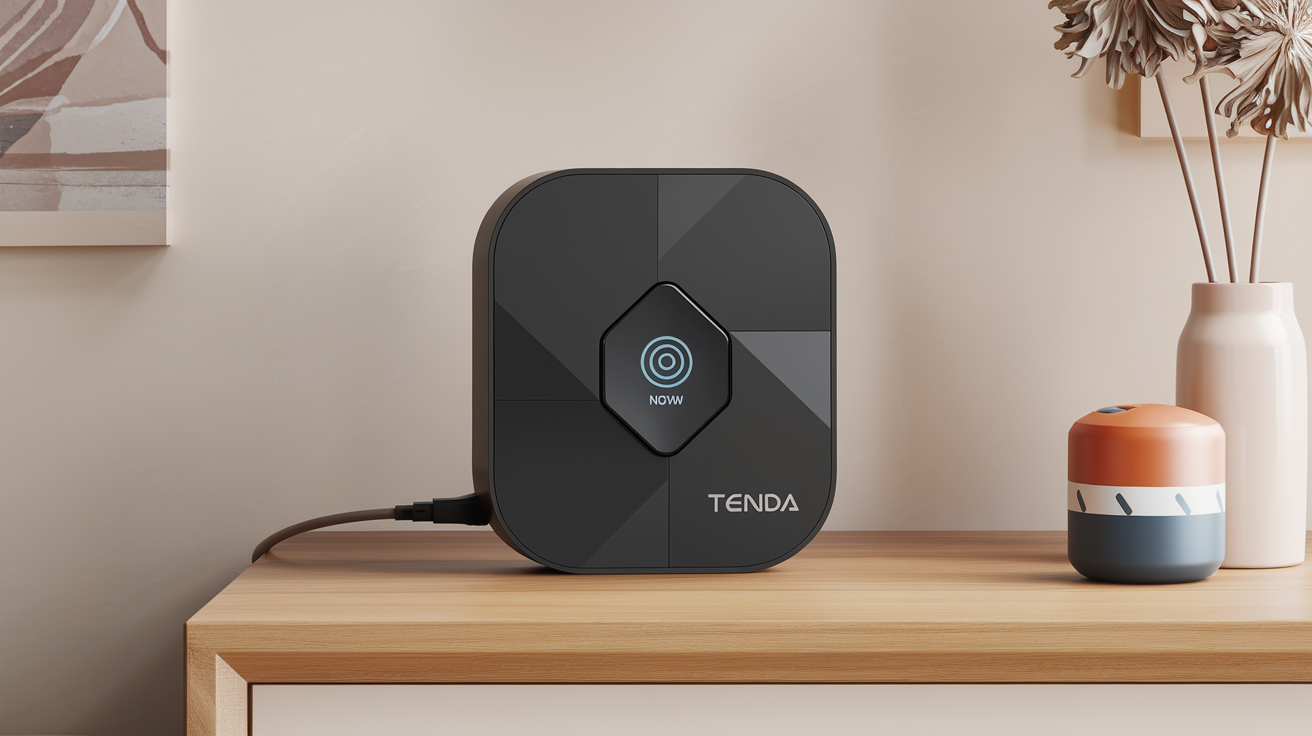Tenda Nova MW5 Description:
The Tenda Nova MW5 is a mesh Wi-Fi system designed to deliver seamless wireless coverage across large areas, making it suitable for both residential and small business environments. Featuring dual-band functionality, the MW5 supports data transmission rates that meet the demands of various applications, such as streaming, gaming, and teleconferencing.
The system’s ability to dynamically adjust to network conditions enhances connectivity by reducing dead spots and maintaining stable connections among multiple devices.
However, while the Tenda Nova MW5 offers commendable capabilities, users may benefit from exploring alternative solutions that provide superior performance or additional features tailored to specific needs. Factors such as bandwidth capacity, coverage area, and device compatibility play crucial roles in optimizing Wi-Fi experiences.
Consequently, evaluating alternative systems can unveil options that better accommodate unique networking requirements or future-proof against expanding technology demands.
In this article, seven top alternatives to the Tenda Nova MW5 will be examined in detail. Each solution will be assessed based on key features pertinent to enhancing network performance and reliability. By identifying these alternatives, readers will gain insights into their available choices for creating an efficient home or office network environment.
Key Features to Consider in Alternatives.
When evaluating alternatives to the Tenda Nova MW5, several key features must be considered to ensure optimal network performance. One of the primary factors is bandwidth capacity, which refers to the maximum data transmission rate supported by the system.
Different users and applications demand varying levels of bandwidth; for example, a household with multiple users engaging in high-definition streaming simultaneously may require a mesh system capable of supporting higher speeds.
Typical metrics include Mbps (megabits per second), where systems offering gigabit connectivity (1 Gbps or higher) would efficiently accommodate demanding tasks like online gaming or 4K video playback.
Another crucial feature is the coverage area provided by the alternative solutions. The range required will vary significantly based on individual living arrangements or business layouts. For instance, large homes with multiple rooms or expansive office spaces benefit from mesh networks designed specifically for seamless coverage without dead zones.
It is advisable to consider both square footage and building materials since concrete walls and other obstructions can hinder signal strength. Most manufacturers provide specifications regarding coverage capabilities, often represented in square feet; hence an assessment should be conducted prior to selection.

Device compatibility also plays a vital role in ensuring that various devices operate effectively within the network ecosystem. As IoT (Internet of Things) devices proliferate—such as smart home assistants, security cameras, and thermostats—it becomes essential for any chosen mesh network solution to support these diverse technologies without degradation in performance.
Ensuring compatibility with emerging Wi-Fi protocols and standards is equally important to future-proof the investment made into networking hardware.
Lastly, additional functionalities such as intuitive mobile application management and advanced security features should not be overlooked when reviewing alternatives.
User-friendly interfaces facilitate easier setup processes and real-time monitoring of network health while robust security measures protect connected devices from potential vulnerabilities. By carefully considering these factors—bandwidth capacity, coverage area, device compatibility, and additional functionalities—consumers can make informed decisions that align with their specific networking needs.
Alternative 1: TP-Link Deco M5.
The TP-Link Deco M5 utilizes advanced mesh technology to provide extensive coverage and maintain consistent connectivity throughout various environments.
Unlike traditional routers that can suffer from signal degradation when positioned far from the source, the mesh system of the Deco M5 employs multiple interconnected units that communicate with one another, ensuring a seamless network experience.
Users can expect robust performance in modest to large homes, effectively eliminating dead zones and delivering stable connections across multiple floors.
In addition to its coverage capabilities, the Deco M5 is equipped with comprehensive security features designed to protect users’ networks. The system includes built-in antivirus protection as part of TP-Link’s HomeCare functionality, which helps defend against malware and various cyber threats.
Additionally, parental controls are integrated within the app, allowing administrators to manage internet access for specific devices or user profiles. This level of security makes it an appealing choice for families looking to safeguard their online presence while still enjoying reliable Wi-Fi service.
Ease of use is paramount for many consumers seeking networking solutions. The TP-Link Deco M5 addresses this through its user-friendly mobile application, enabling straightforward setup and management without requiring extensive technical knowledge.
The app provides step-by-step installation guides and allows users to monitor network performance in real time. Features such as device prioritization can also be managed effortlessly via the app, giving users control over bandwidth allocation based on individual needs or preferences.
Overall, the TP-Link Deco M5 stands out as a versatile alternative to the Tenda Nova MW5 due to its combination of effective mesh networking capabilities, strong security provisions, and intuitive management tools.
Whether for a home or small business setting, users will likely find that this system meets their expectations while providing enhanced performance relative to more conventional Wi-Fi solutions.
Alternative 2: Netgear Orbi RBK50.
The Netgear Orbi RBK50 stands out as a formidable alternative to the Tenda Nova MW5, particularly due to its high-speed Gigabit connectivity. This capability is enhanced by a dedicated backhaul channel that ensures seamless data transmission between the router and satellite units, effectively minimizing congestion during periods of heavy use.
Such configuration is especially beneficial for environments where multiple devices are continuously streaming high-definition content or engaging in online gaming, where latency is critical.
Coverage area is another key strength of the Orbi RBK50. It includes multiple antennas strategically positioned within its architecture to extend Wi-Fi reach across large spaces, potentially covering areas of up to 5,000 square feet with robust signal strength.
The powerful design reduces potential dead zones, making it suitable for various layouts including homes with thick walls or multi-story configurations. This extensive range allows users to maintain connectivity in different rooms without experiencing a drop in performance.

Furthermore, the advanced Quality of Service (QoS) settings present in the Orbi RBK50 allow for effective management of bandwidth allocation among connected devices.
For instance, users may prioritize network traffic for devices engaged in critical tasks such as video conferencing or online gaming over less urgent applications like file downloads or social media browsing.
This prioritization capability not only enhances user experience but also ensures that essential operations remain unaffected during times of high network activity.
In summary, the Netgear Orbi RBK50 provides an exceptional option for users seeking reliable and fast Wi-Fi solutions. Its combination of Gigabit connectivity, expansive coverage through multiple antennas, and intelligent QoS settings affords significant advantages over competitors like Tenda Nova MW5.
These features make it a worthy consideration for both home networks and small business applications requiring efficient internet service.
Alternative 3: Google Nest WiFi.
Google Nest WiFi is designed to seamlessly integrate with a variety of smart home devices, providing users with a unified ecosystem that enhances overall connectivity and efficiency.
This compatibility includes devices such as smart thermostats, lighting systems, and security cameras within the Google Home environment. Users can manage their entire network through voice commands via Google Assistant, ensuring easy access to device settings without navigating multiple applications or interfaces.
In terms of functionality, Google Nest WiFi employs a flexible mesh configuration that allows for customized coverage tailored to specific environments. The system consists of a primary router connected to the modem and one or more additional nodes placed throughout the desired area.
Each node communicates with the main router to distribute signal evenly, making it straightforward to eliminate dead zones in larger homes or offices. For example, by placing an additional node in a remote corner of a house, users can ensure reliable coverage in spaces that previously experienced weak signals.
The design elements of Google Nest WiFi further enhance its appeal; each unit incorporates an unobtrusive aesthetic that blends harmoniously with modern interiors. Additionally, the built-in voice assistant capabilities allow users not only to manage their network but also control other smart devices conveniently.
This integration facilitates actions such as adjusting lighting while streaming media on supported platforms — all achievable through simple vocal instructions.
In conclusion, Google Nest WiFi presents an effective alternative for those seeking advanced features like smart home integration and flexible coverage options. Its user-centric design combined with robust performance makes it suitable for various networking needs while maintaining ease of use for consumers at any tech proficiency level.
Alternative 4: Linksys Velop MX10.
The Linksys Velop MX10 utilizes tri-band technology, which designates one band specifically for backhaul communication between nodes. This architecture minimizes congestion and ensures that high-demand applications such as gaming and streaming operate smoothly.
With a maximum throughput of up to 5.3 Gbps across its bands, the system is capable of supporting multiple devices simultaneously without degradation in performance. This feature makes the Velop MX10 an ideal choice for homes with heavy internet usage or for small businesses reliant on uninterrupted digital services.
In addition to its robust performance capabilities, the Linksys Velop MX10 features a modular design that allows users to easily expand their network as needs evolve.
The system includes two nodes out of the box, but additional nodes can be added seamlessly to cover larger areas or eliminate dead zones within existing coverage gaps.
This flexibility proves advantageous in environments where infrastructure may change or when more devices are connected over time, thus eliminating concerns regarding network expansion and maintaining resilient connectivity throughout dynamic settings.

Management of the network is user-friendly through the Linksys app, available for both iOS and Android platforms. The app provides comprehensive control over various functions including device prioritization, parental controls, and in-depth analytics concerning data consumption and network status.
Users receive notifications about security vulnerabilities and unauthorized access attempts, ensuring a vigilance towards cybersecurity while monitoring overall performance metrics effectively. Such capabilities enhance not only user experience but also empower administrators by providing insights necessary for optimizing their networking environment.
By choosing the Linksys Velop MX10, consumers invest in a future-proof solution designed to meet increasing demands for bandwidth and reliability. Its tri-band functionality coupled with easy scalability makes it suitable for current technological standards while preparing users for evolving needs down the line.
Whether streamlining operations at home or facilitating connectivity in a professional setting, this Wi-Fi solution stands out as a competitive alternative to the Tenda Nova MW5 while addressing key challenges inherent in modern connectivity requirements.
Alternative 5: ASUS ZenWiFi AX (XT8).
The ASUS ZenWiFi AX (XT8) is a powerful mesh Wi-Fi system that supports the latest Wi-Fi 6 technology. This enhancement offers significant improvements in wireless data transmission rates compared to its predecessors, allowing for higher speeds and better performance across multiple connected devices simultaneously.
Users with bandwidth-intensive applications, such as high-definition streaming, online gaming, or video conferencing, will notice reduced latency and increased capacity. Wi-Fi 6 utilizes features such as Orthogonal Frequency Division Multiple Access (OFDMA) and Target Wake Time (TWT), which optimize network efficiency.
In addition to faster speeds, the ASUS ZenWiFi AX incorporates AI-driven capabilities that enhance security and manageability. The built-in AiProtection Pro software provides advanced malware protection and ensures privacy through automatic vulnerability detection against threats.
Furthermore, traffic optimization helps allocate bandwidth where it is needed most, effectively prioritizing critical applications during peak usage times. This level of automated management not only enhances user experience but also simplifies network administration for those who may lack technical expertise.

Customization options are another notable aspect of the ASUS ZenWiFi AX system. Users can fine-tune their network settings through an intuitive web interface or mobile application that provides easy access to configuration options.
Adjustable settings include parental controls that enable restrictions on internet access based on user profiles or time schedules. Advanced users can modify settings related to Quality of Service (QoS) preferences further improving device performance according to individual requirements.
Overall, the ASUS ZenWiFi AX (XT8) presents a compelling alternative to the Tenda Nova MW5 for users seeking a robust mesh networking solution equipped with next-generation technology and advanced management features.
With its combination of speed, security, and flexibility, this system is suited for both small offices and households with extensive device connectivity needs.
Alternative 6: D-Link Covr-C1203.
The D-Link Covr-C1203 is a dual-band mesh Wi-Fi system engineered to deliver seamless coverage across expansive areas, effectively eliminating dead zones that can disrupt connectivity.
This capability is particularly beneficial in larger homes or small business environments where multiple rooms and floors may impede wireless signals.
By utilizing a combination of both the 2.4 GHz and 5 GHz frequency bands, the Covr-C1203 dynamically adjusts signal distribution based on real-time network demands, ensuring optimal performance for various applications, including streaming, gaming, and video conferencing.
One notable feature of the Covr-C1203 is its integrated parental controls, which enhance security by allowing administrators to manage internet access for connected devices.
Users can set filters to restrict specific content types, schedule online access times for different devices, or pause the internet during designated periods. These functionalities promote safe internet usage among children or users with sensitive needs while providing peace of mind to parents and network administrators alike.
Installation processes are often cited as pain points in setting up mesh networks; however, the D-Link Covr-C1203 simplifies this experience significantly. Its design allows for easy compatibility with existing modem setups without requiring advanced technical knowledge.
Clear instructions guide users through the setup process via a user-friendly mobile application that also provides ongoing management tools. This app offers insights into network activity and device performance, enabling users to troubleshoot potential issues proactively.
Overall, the D-Link Covr-C1203 presents itself as a strong contender among Wi-Fi solutions due to its ability to provide extensive coverage while incorporating practical features such as parental controls and straightforward installation.
For consumers seeking an effective alternative to Tenda Nova MW5 that addresses their need for reliability and security in their wireless networking environment, the Covr-C1203 warrants serious consideration.
Alternative 7: Xiaomi Mi AIoT Router AX3600.
The Xiaomi Mi AIoT Router AX3600 is engineered with high-performance hardware, prominently featuring a Qualcomm chipset. This chipset is designed to optimize processing efficiency, which enables the router to handle multiple data streams concurrently.
As a result, this capability supports a seamless experience for households or small businesses that require robust Wi-Fi performance for activities such as online gaming, video streaming, or teleconferencing.
The AX3600 also adheres to the Wi-Fi 6 standard, providing access to advanced features like Orthogonal Frequency Division Multiple Access (OFDMA), which allows more devices to connect without experiencing significant degradation in network speed.
To enhance coverage and reduce signal interference, the Xiaomi Ax3600 employs an impressive array of multiple antennas strategically positioned throughout its design.
This multi-antenna configuration ensures that the network signals are distributed efficiently across various areas within a home or office environment.
Additionally, beamforming technology plays a critical role by directing Wi-Fi signals towards connected devices rather than broadcasting them uniformly, resulting in improved connection stability and speed in areas further away from the router.

In support of user-friendly operations, the Xiaomi Mi AIoT Router AX3600 includes smart management tools accessible via a dedicated mobile application. Through this application, users can remotely monitor their network’s performance and make adjustments as necessary.
Features such as bandwidth allocation allow administrators to prioritize connectivity for specific devices; thus ensuring important applications maintain optimal performance during peak usage periods.
The application also enables users to manage security settings effectively, including firewall configurations and parental controls tailored to individual use cases.
Overall, the Xiaomi Mi AIoT Router AX3600 presents itself as a formidable alternative to the Tenda Nova MW5 due to its combination of high-performance processing power, expansive coverage capabilities through advanced antenna design, and comprehensive management functions provided via its app interface.
Such characteristics make it suitable for technologically demanding environments where reliable and efficient internet connectivity is paramount.
Conclusion.
In summary, the alternatives to the Tenda Nova MW5, including options such as TP-Link Deco M5, Netgear Orbi RBK50, and others, each present distinct advantages tailored to specific user requirements.
Key considerations such as bandwidth capacity, coverage area, and device compatibility were highlighted throughout the article to facilitate informed decision-making.
These alternatives offer enhanced performance features including advanced security protocols, expanded range capabilities, and user-friendly management applications.
Before selecting a suitable Wi-Fi solution, it is advisable for consumers and network administrators to thoroughly assess their particular needs regarding network traffic and layout.
Additionally, systematic upgrading of existing network systems can significantly contribute to improved performance and reliability in both home and business environments. This approach ensures that users derive maximum value from their chosen technology while maintaining optimal connectivity across various devices.
I am commitment to crafting compelling narratives and delivering insightful content continues to inspire and inform readers across various platforms. Explore her articles on AlternativesZone.com and FactAfterFact.com to experience a rich tapestry of knowledge and discovery. Here I Analyze and Test the products and services together with my team before we recommend them to our users. Nice Reading Here!











